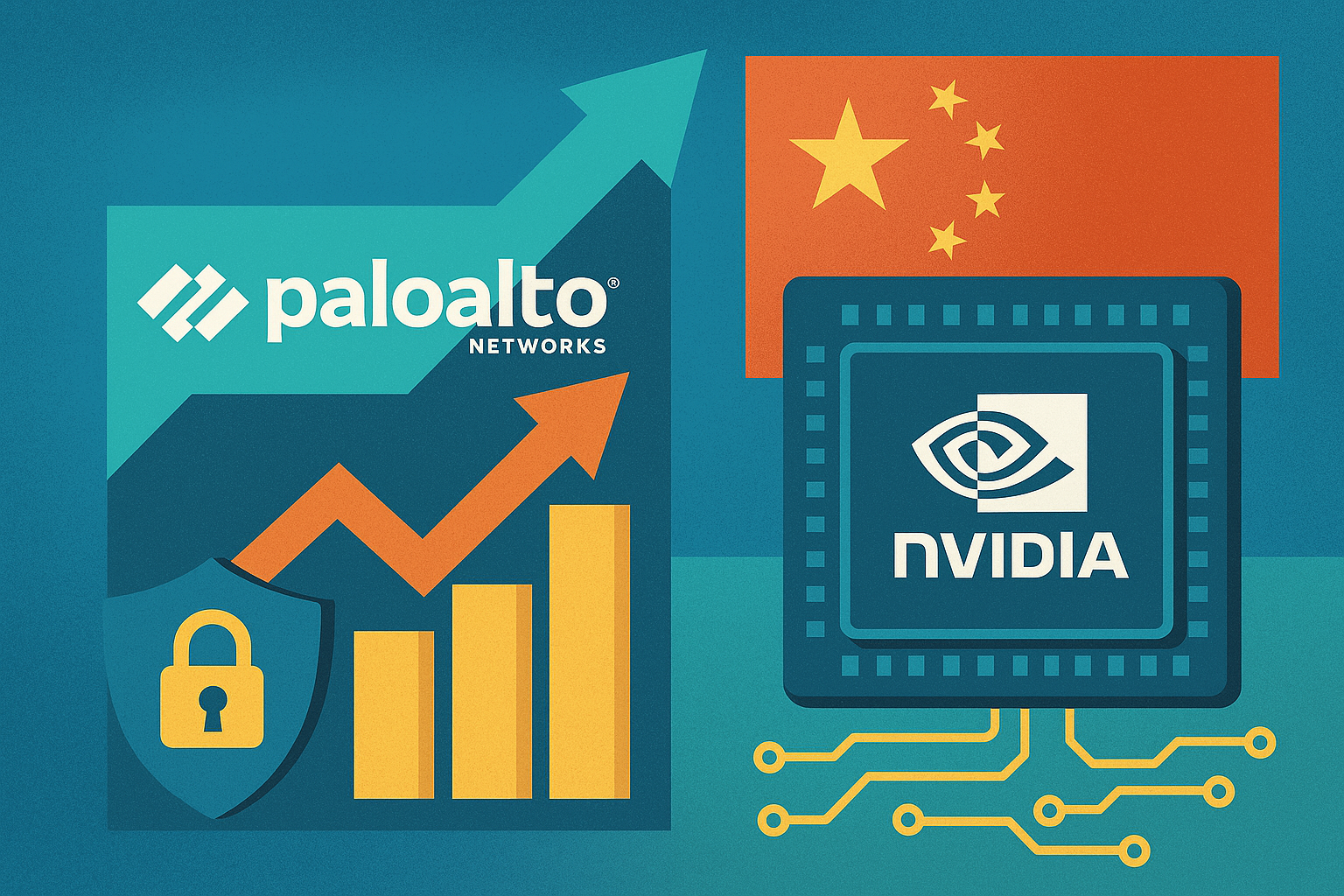Global markets were jolted with a fresh dose of optimism this week as Palo Alto Networks delivered robust earnings, sending its shares surging, while Nvidia made headlines for its strategic development of a China-focused AI chip. Together, the stories highlight two converging themes investors can’t ignore: the insatiable demand for cybersecurity and the ongoing tug-of-war over AI technology in geopolitically sensitive markets.
Palo Alto Networks’ Earnings Spark Cybersecurity Momentum
Palo Alto Networks (NASDAQ: PANW) soared over 6% in after-hours trading following quarterly results that beat Wall Street expectations. The company reported adjusted earnings per share of $0.95 on revenue of $2.54 billion, surpassing consensus estimates tracked by Investopedia and Reuters.
The strength reflects accelerating demand for enterprise-grade cybersecurity solutions as digital threats proliferate across industries. Analysts noted broad-based growth across Palo Alto’s product and platform lines, with recurring revenue streams underpinning its long-term visibility.
Wedbush Securities highlighted that cybersecurity remains one of the most resilient IT spending categories, even in a cautious macro environment. “Enterprises can delay other tech investments, but they cannot afford to skimp on cybersecurity when the stakes are this high,” wrote Dan Ives, a well-known tech analyst at Wedbush.
For investors, Palo Alto’s performance underscores the durability of cybersecurity spending, a theme reinforced by increasing cyber incidents tied to both private hackers and state-sponsored actors.
Nvidia’s New AI Chip: A Strategic Play in China
Meanwhile, Nvidia (NASDAQ: NVDA) is reportedly developing a new artificial intelligence chip tailored specifically for China, according to Reuters. This move comes amid continued U.S. export restrictions that have curtailed Nvidia’s ability to ship its most advanced chips into the Chinese market.
The new chip is designed to comply with U.S. regulations while still meeting demand from China’s AI sector—the world’s second-largest AI market. Analysts suggest this could allow Nvidia to retain its foothold in China without triggering regulatory backlash.
However, the geopolitical stakes are high. Washington continues to tighten restrictions on semiconductor exports to China, citing national security concerns, while Beijing is accelerating efforts to build a self-sufficient chip ecosystem. Nvidia’s strategy could deliver short-term growth but remains vulnerable to sudden policy shifts.
Bloomberg Intelligence noted that Nvidia’s China sales accounted for roughly 20–25% of data center revenue before export curbs began. Regaining a portion of this market could be meaningful for top-line growth, especially as AI infrastructure spending shows no sign of slowing globally.
Why This Matters for Investors
- Cybersecurity as a Defensive Play: Palo Alto’s results reaffirm that cybersecurity is less cyclical than other IT verticals, making it a core holding for investors seeking resilience in volatile markets.
- AI’s Geopolitical Chessboard: Nvidia’s China strategy illustrates the tightrope global tech companies must walk between regulatory headwinds and market opportunity. For investors, this highlights both upside potential and risk concentration in semiconductors.
- Sector Divergence: While cybersecurity benefits from a predictable demand curve, semiconductors remain exposed to geopolitical disruptions—suggesting a need for balanced exposure across the two themes.
Future Trends to Watch
- Cybersecurity Consolidation: Expect continued M&A activity in cybersecurity as firms race to offer end-to-end platforms. Palo Alto itself has been active in strategic acquisitions.
- AI Infrastructure Build-Out: Cloud providers and enterprises are set to accelerate AI infrastructure spending, keeping Nvidia at the center of capital allocation themes.
- Geopolitical Policy Shifts: Investors should monitor U.S.-China relations closely. Any new export restrictions could reshape Nvidia’s outlook overnight.
- Resilient IT Spending: While broader IT budgets remain under scrutiny, cybersecurity and AI are among the most protected categories—a trend that could buoy sector valuations.
Key Investment Insight
Investors should view Palo Alto Networks as a durable play on rising cybersecurity demand, with its earnings reinforcing the sector’s resilience. Meanwhile, Nvidia remains a leader in AI infrastructure, but its China-focused strategy is a double-edged sword: a potential growth driver if successful, yet vulnerable to regulatory risk. A balanced approach—combining cybersecurity exposure with selective semiconductor bets—may offer the best risk-reward profile.
Global tech and security markets are evolving at breakneck speed, where policy, innovation, and enterprise demand intersect. Staying informed is critical. For daily, investor-focused insights, follow MoneyNews.Today—your go-to source for the news that moves markets.





